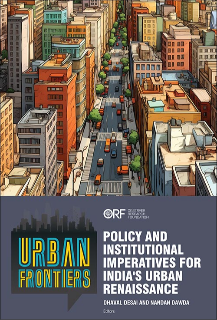Editors’ Note
India’s urbanisation is at a critical juncture, with unprecedented opportunities emerging amid formidable challenges. With more than 50 percent of the country’s population expected to live in cities by 2047,[1] rapid urban growth will radically transform India’s demographic landscape, putting enormous stress on urban services and resources. While the imminent urban expansion has immense potential for contributing to prosperity, it is riddled with numerous complexities and challenges that impede inclusive, resilient and sustainable growth for all.
Indeed, as cities are poised to propel national economic growth momentum, governments across the federal tiers must rethink the country’s urban governance mechanisms and institutional architectures if India is to maintain its promised growth trajectory in the Amrit Kaal[2] (or “immortal era”, the 25-year period from 2022 to 2047, when India turns 100).[3] At this critical urban moment for India, ORF publishes this unique anthology, “Policy and Institutional Imperatives for India’s Urban Renaissance,” which seeks to illuminate pathways for innovative governance frameworks and institutional reforms in the country.
The compendium is divided into two sections. The first section focuses on rethinking urban policy frameworks and innovative institutional reforms, and the second deals with the need for coordinated governance across all the government tiers and how states and cities must respond to the opportunities brought forth by Central schemes. The 14 articles intersect at certain points, as they equally aim to explore themes of governance, policy frameworks, and institutional mechanisms.
Governance lies at the heart of effective urban management—the cornerstone for formulating, implementing, monitoring, and evaluating policies. This compendium examines governance mechanisms and the intricate interplay between central, state, and local authorities. It sheds light on the evolving nature of governance structures and the imperative of adaptive, responsive governance amid existing and emerging urban complexities.
Policy frameworks serve as blueprints for action, delineating the goals, strategies, and interventions necessary to drive sustainable urban development. Our contributing authors explore policy imperatives across various domains—from urban planning and infrastructure to housing, transportation, water, environmental sustainability, and social security. The articles draw upon evidence-based and comparative analyses to offer insights into the efficacy of existing policies and propose innovative approaches to address emerging urban challenges.
Institutional mechanisms provide the scaffolding to translate governance aspirations and policy directives into tangible on-ground outcomes. Our authors underscore the need for institutional reform, capacity building, and innovation to enhance the resilience and effectiveness of urban governance structures.
Beyond widening the scope of academic discourse, this publication offers practical insights for policymakers and urban practitioners, and outlines actionable knowledge to tackle real-world challenges confronting an urbanising India.
Hitesh Vaidya and Chetan Vaidya open the volume with their article where, citing examples of global cities, they identify India’s policy gaps and institutional infirmities and explore recommendations for how India can achieve people-centred urban development. This, the authors argue, should have a strategic focus, and promote multi-level coordination, data-driven, collaborative and participatory governance; as well as capacity building and fiscal empowerment of city governments.
Confronting the delicate issue of delimitation of election constituencies that has led to certain urban agglomerations being underrepresented in the state Legislatures and the Lok Sabha, Ritwika Sharma calls on the Government of India to pave the way for the immediate rollout of the pending Census of India and conduct a fresh delimitation exercise. Delimitation has implications for representative democracy and federalism, and it must no longer remain a political domain but become a collaborative exercise, with the active engagement of experts in political science, urban governance, constitutional law, and psephology.
Nandan Dawda then charts the evolution of India’s urban transport policies, explaining how the unresolved challenges in their practical implementation and the lack of integration between various transport schemes and missions have created unsustainable transportation systems in Indian cities. The author recommends holistic policy reforms focusing on integrated transport planning, covering all modes of transportation, both public and private.
In their piece, Himani Jain and Sourav Dhar also tackle the subject of urban transport, and propose the setting up of a Regional Unified Transport Authority (RUTA) whereby each region can have mobility interdependence with at least one million-plus city or a large economic hub or urban continuum. Consolidated mobility services markets will facilitate private sector participation, synchronise public transit planning, and optimise operations costs.
Sivasubramaniam Jayaraman and Vaishali Singh, for their part, examine the progressive measures taken by several cities across India to rethink urban transport policies and institutions. They call for the broader and deeper adoption of autonomous Unified Metropolitan Transport Authorities (UMTAs) in all cities with the financial empowerment and decision-making freedom to meet the ever-changing urban transportation demands.
Yet, transportation is only one among the critical issues that cities need to address if they were to become truly engines of growth and development; an equally urgent imperative is to tackle the grave gaps in women’s safety and security. In their article, Nikhat Shaikh and Ankita K enumerate the critical role of One-Stop Centres (OSCs), offering the experience of two OSCs in Mumbai for lessons and calling for these centres to be upscaled.
Rounding off the first section is a contribution from Vinita Ajgaonkar and Rama Shyam, which discusses the findings from a primary survey of the beneficiaries of all the Central and state government social welfare schemes in informal settlements across the Mumbai Metropolitan Region. The survey aimed to identify the hurdles encountered by these schemes in reaching the eligible targeted beneficiaries. They recommend specific interventions that will consider the ground realities confronting the urban poor to broaden existing social safety nets through improved mechanisms to measure ‘absolute poverty’ indicators in urban India.
The second section of this compendium begins with an article by Ramanath Jha, evaluating the Central government’s efforts for urban reforms through decentralised governance and financial empowerment of the Urban Local Bodies (ULBs). The author cautions that “there is no space for unfunded mandates for the well-being of the ULBs,” underscoring why the Government of India must rethink its approach and be involved more with its cities if the country is to achieve its promise of becoming an economic powerhouse by 2047.
In the subsequent essay, Deepty Jain advocates both top-down and bottom-up targeted approaches at the national and state levels with an integrated reporting and monitoring system to identify potential strategies for achieving the SDGs and India’s net-zero commitments.
Sejal Patel then highlights the need to align the states and cities with the ‘rightsized’ role of the Government of India to address the growing shortage of affordable housing in India’s cities. Evaluating the performance of the Pradhan Mantri Awas Yojana-Urban (PMAY-U) and its various sub-schemes, she urges the Ministry of Housing Urban Affairs to conduct regular performance and reform audits of all the housing projects planned and implemented by the states and ULBs.
Highlighting the numerous overlapping mandates in city governance between the ULBs, state departments and parastatals and the state’s predominance in decision-making, Dhaval Desai calls for the emancipation of the third tier of government as India aspires to grow as a developed economy by 2047.
Janak Parmar, in his article, makes a case for the proactive implementation of the ULB governance and institutional reforms mandated by the central government. He advocates for a more assertive role of the Government of India through dedicated monitoring mechanisms, regular and transparent audits, and performance reviews.
What follows is a piece by Saswat Bandyopadhyay and Gargi Mishra, which highlights the fragmented infrastructure delivery and poor land-use planning in India. They advocate for a ‘City Infrastructure Investment Pipeline’ of projects prioritised and aligned with spatial evidence-based development plans of cities, optimally leveraging the land value appreciation through planned urban growth.
Vikas Rana closes the volume explaining why and how, amid the water crises facing urban India, cities must turn the problem of wastewater generation into an advantage. This can be done, he argues, by establishing the necessary strategies and mechanisms to achieve a circular water economy.
As India embarks on its journey toward an urban renaissance, the need for informed, collaborative action has never been more pressing. It is our hope that the expert insights curated in this publication will provoke debates and inspire innovation, which in turn can help propel India’s cities toward a future that is prosperous, sustainable, and inclusive.
This volume is a testament to the collective wisdom of scholars, policymakers, and practitioners who have dedicated themselves to understanding India’s urban dynamics. It recognises the pivotal role of government and its multiple institutions in steering the course of urbanisation and how the effectiveness of governance machinery and institutional architecture—from municipal administrations to national policies—profoundly influences the liveability, resilience, and equity of urban spaces.
- Dhaval Desai and Nandan Dawda
Read the report here.
[1] National Institute of Urban Affairs, Leave No One Behind: A Policy Framework on Urban Social Protection, New Delhi, National Institute of Urban Affairs, 2023.
[2] Ministry of Education, Government of India.
[3] Impact and Policy Research Institute, Pathways to Amrit Kaal: “Envisioning and Realising a New Future for Indian Cities”, New Delhi, Impact and Policy Research Institute, 2023.
The views expressed above belong to the author(s). ORF research and analyses now available on Telegram! Click here to access our curated content — blogs, longforms and interviews.

 PDF Download
PDF Download



 PREV
PREV



